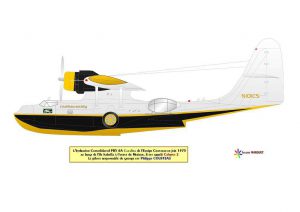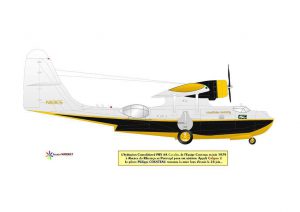PBY Catalina Calypso 2

Je vais essayer de vous faire découvrir ce que fut l'hydravion de Philippe Cousteau comment ce pélican des airs, est devenues en quelques documentaires un élément incontournable de l'armada de l'équipe Cousteau
ci dessous vous découvrez une représentation de l'hydravion par ordinateur
Hydravion PBY Catalina:
Les hydravion PBY Catalina ont connu leur heure de gloire militaire au cours de la seconde guerre mondiale.
P.B.Y signifie Patrol Bomber Y . Ces bombardiers patrouilleurs ont été conçus pour voler loin longtemps et au prix d'un entretien des plus rustiques. Celui de Philippe Cousteau fut acheté à Fort-Lauderdale, Floride.
L'hydravion Calypso 2 constituait un engin de reconnaissance et d'exploration extraordinaire, superbement aménagé pour emporter 8 hommes. Il était équipé de nombreuses trappes pouvant être ouverte à tout moment afin de faire des prises de vues aériennes photographiques comme cinématographiques
L'hydravion catalina PBY Calypso 2 est un engin qui peut se poser comme décoler à faible vitesse soit 70 kilomètre heure ce qui l'autorise à utiliser de petit plan d'eau. Sa vitesse de croisière est de 120 noeuds soit environs 215 kilomètre heure. Son rayon d'action dépasse les 1000 milles.
plan Wikipédia

L'hydravion de Philippe Coustea fut immatriculé :
PBY 6A (bu 640) N101CS
Il fut acheté dans un des dépot militaire de la base de Fort Lauderdale pour la sommes de 80000 dollards.
Il traversa l'Atlantique afin d'être réaménagé au ateliers aéronautiques de la 6 ème flotte de l'U.S Navy statinnée à Alvérea au Portugal en 1974.
L'hydravion est équipé de 2 moteurs Pratt and Whitney (R-1830-92 twin wasp d'une puissance chacun de 1200ch.
Configuration moteur: 14 cylindres en double étoiles ( twin wasp)
suralimentation puissance au sol 1200ch à 27000 tours minutes
Moteur 3 pales
refroidissement à air
Masse à vide: 7947 kg
masse totale décollage au sol: 15400 kg
masse totale décollage sur l'eau: 13500kg
plafond d'utilisation: 20000pieds environs 7300 ms
rayon d'action: 3800 miles environs 6500 kms
intérieur local radio du catalina doc Daniel Bélanger

Information relative à l'accident de Philippe Cousteau:
L'hydravion catalina venait de décoller de l'aérodrome militaire d'Alvera, il venait de subir des travaux d'entretiens au Chantier OGMA ( officinas gerais de matériel aéronaitico )
Lors de ce dramatique accident en plus de la disparition de philippe Cousteau, son co-pilote JP Gros eu le bras gauche partiellement sectionné et le plongeur Dan Phan fut lui beaucoups plus légerement bléssé.
voici quelques liens que je vous invite à regarder ( doc envoyé par Mr Pedro Borralho) Hidroaviao Calypso
The first piece, broadcast on June 26th, 1979, is 2m52s long colour and black and white segment, entitled « The Calypso Seaplane ». It is about the deliverance of the Catalina to L'Équipe Cousteau which took place on that same day, after nearly a 5 months repair at the Portuguese Air Force Repairing Unit (OGMA). It includes an interview made in french to Philippe Cousteau and another in portuguese to the Director of OGMA. We can also see several scenes of the Catalina inside de repair shop, taxing the runway and taking off to Castelo do Bode Dam. We can also see other aircraft (USN Grumman S-2 Tracker) inside the OGMA repair shop. It should be noticed that this piece, as the following one, are very focused on showing the expertise of OGMA, as this Repair Unit was making a transition from the Portuguese Colonial War period (1961-1974), to a new era where, in order to maintain its working force, it had to find new markets – including the private sector. Philippe Cousteau talks about the Catalina and how a decision was made to choose OGMA among other competitors on Europe and Africa (surprinsigly he does not mention the USA as a possibility for repairs).
https://arquivos.rtp.pt/conteudos/hidroaviao-calypso-2/
The next piece, aired at the same day, is a 2m37s colour segment about the air trials of the Catalina at the Castelo do Bode Dam, north of Lisboa. This clip includes another interview in french to Philippe Cousteau, where he is very clear about how pleased he feels with the repairs made and the role of the Catalina on future Cousteau Expeditions. The aircraft is shown in almost pristine conditions as it had been painted new. A reference is made to a need in making some final adjustments and about leaking problem on the hull of the Catalina (which would lead to new trials and the tragic incident at Tagus river, only 2 days later). The segment ends with the Catalina taking off from Castelo do Bode followed very close by a Portuguese Air Force Allouette III helicopter (at the time the most common example of our Air Force).
https://arquivos.rtp.pt/conteudos/funeral-de-philippe-cousteau/
saddest and most touching one it's a 2m22s colour segment, entlited « Philippe Cousteau's Burial ». It was aired on July, 5th 1979 and it's about the sea burial of Philippe Cousteau, that took place on the same day. One can see the funeral mass at the Church of Saint Louis of the French, in Lisboa at 07:00 am. We then follow the car's procession that takes the coffin of Philippe Cousteau to the NATO/OTAN dock at Trafaria, Almada, on the opposite side of Tagus mouth, where it was put aboard the corvette Baptista e Andrade F486. We are then showed the final moments of the coffin aboard the corvette and the sea burial itself, that happened some 20 miles southwest of Bugio Fortress, on the Atlantic Ocean, a location with an average depth of 2.000m. Among the presents, we can see Jacques-Yves Cousteau, Jean-Michel Cousteau, Simone Cousteau, Janice « Jan » Sullivan (his widdow) and several other members of the family and friends. We are also told of the presence of 5 members of the Calypso team among those attending the sea burial.









